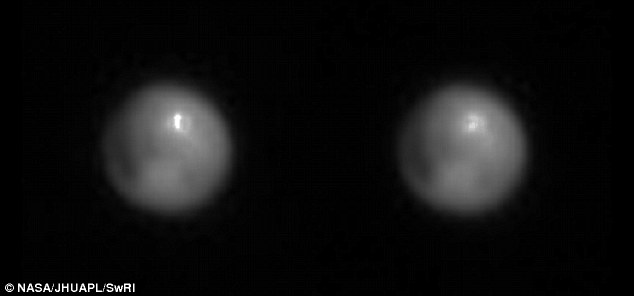

This week, scientists discovered something a little strange on the tiny dwarf planet at the edge of our solar system. As New Horizons races towards Pluto, it is continually snapping images, and the latest reveal a mysterious bright spot, one that looks much like the spots that we’ve seen on Ceres.
Notably, in the images, the contrast and brightness have been increased so that the spot can be seen. Consequently, you shouldn’t assume that there is some white light emanating from the small world. Rather, the most likely hypothesis is that this spot is frozen methane or water ice on the surface.
The spots, while notable from a scientific perspective, aren’t terribly unexpected. Pluto is some 3.67 billion miles (5.9 billion km) from the sun. For comparison, Earth has an average orbit of just 92 million miles (150 million km). Ultimately, Pluto is so far out into our solar system, it takes more than 247 Earth-years for it to complete one orbit. And with a temperature reaching -387º Fahrenheit (-233º Celsius), vast amounts of frozen material is anticipated.
If the images seem a little blurry to you, it is because, despite the fact that new Horizons has been traveling for 10 years in order to reach its target, it is still 14.2 million miles (22.9 million km) from Pluto. At its closest approach, New Horizons is due swing in around 7,750 miles (12,500 km) from the surface of the dwarf planet. This rendezvous is scheduled for just two weeks away (July 14, 2015).
Phil Plait, an astronomer and science communicator who writes over at Slate, was one of the first to note the spot, and discussed the images in detail over at his blog.

Plait writes, “I wondered if perhaps this was an image artifact, like a particle hit on the detector, but in fact it’s the same in the other image taken 30 seconds earlier.” He adds, “the important thing to note is that it’s seen in both pictures. I’ll note too that Pluto was in a different spot in the camera’s field of view, too, so this isn’t some bad lone pixel either, messing with the shot. This bright spot is quite real. Measuring the pixel brightnesses, it looks to be about twice as bright as the surface around it.”
Thus far, we have only had an opportunity to study this world from a distance…a rather long distance. However, thanks to New Horizons (and some other space telescopes) we have uncovered a number of things about the world.
Unlike the other major planets in our solar system, Pluto has an orbit that is highly elliptical. Each revolution, Pluto swings in towards the Sun. As it hurtles closer to our star, the dwarf planet heats up and develops a thin atmosphere. Following this, it careens out towards the farthest reaches of the solar system…freezing…becomi
On top of its extremely eccentric orbit, Pluto’s flight path is inclined by more than 17°, so Pluto appears to sweep in an angle across the plane upon which the other planets revolve.
Astronomers will have an opportunity to uncover more about Pluto, and these bright spots, as New Horizons continues its approach.